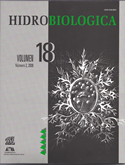Aspects of reproductive biology of the geoduck clam Panopea globosa (Dall 1898) in the Gulf of California
Keywords:
Panopea globosa, Geoduck clam, reproductive biology, Gulf of California.Abstract
This paper describes basic aspect of reproductive biology of the geoduck clam Panopea globosa from a population in the east central Gulf of California. Geoduck clams were collected monthly for a year (October 2004-October 2005), The gonadosomatic index and ovocyte growing (oocyte diameters) techniques were used to determine the spawning timing. Reproductive period was related with in situ temperature and seawater surface temperatures (SST) from the Comprehensive Oceanic and Atmospheric Data Set. Reproduction phases were similar to other geoduck clams in New Zealand and Canada. Gametogenesis begins in autumn and spawning occurred between January and February winter), when SST were at their coolest (~18 oC). We found that P. globosa spawned at comparable temperatures as P. zelandica in the southern hemisphere, but the reproductive strategy of the California geoduck clam seemed closer to P. abrupta of the northern hemisphere because spawning occurred in association with increased seawater temperature. Results represent the basis for future studies on the biology, ecology, and fishing potential of this geoduck clam.Downloads
Downloads
Published
How to Cite
Issue
Section
License
Los autores/as que publiquen en esta revista aceptan las siguientes condiciones:
De acuerdo con la legislación de derechos de autor, HIDROBIOLÓGICA reconoce y respeta el derecho moral de los autores, así como la titularidad del derecho patrimonial, el cual será cedido a la revista para su difusión en acceso abierto.
Publicar en la revista HIDROBIOLÓGICA tiene un costo de recuperación de $500 pesos mexicanos por página en blanco y negro (aproximadamente 29 dólares americanos) y $1000 pesos por página a color (aproximadamente 58 dólares americanos).
Todos los textos publicados por HIDROBIOLÓGICA sin excepción se distribuyen amparados bajo la licencia Creative Commons 4.0Atribución-No Comercial (CC BY-NC 4.0 Internacional), que permite a terceros utilizar lo publicado siempre que mencionen la autoría del trabajo y a la primera publicación en esta revista.
Los autores/as pueden realizar otros acuerdos contractuales independientes y adicionales para la distribución no exclusiva de la versión del artículo publicado en HIDROBIOLÓGICA (por ejemplo incluirlo en un repositorio institucional o publicarlo en un libro) siempre que indiquen claramente que el trabajo se publicó por primera vez en HIDROBIOLÓGICA.
Para todo lo anterior, el o los autor(es) deben remitir el formato de Carta-Cesión de la Propiedad de los Derechos de la primera publicación debidamente requisitado y firmado por el autor(es). Este formato se puede enviar por correo electrónico en archivo pdf al correo: enlacerebvistahidrobiológica@gmail.com; rehb@xanum.uam.mx (Carta-Cesión de Propiedad de Derechos de Autor).
Esta obra está bajo una licencia de Creative Commons Reconocimiento-No Comercial 4.0 Internacional.


